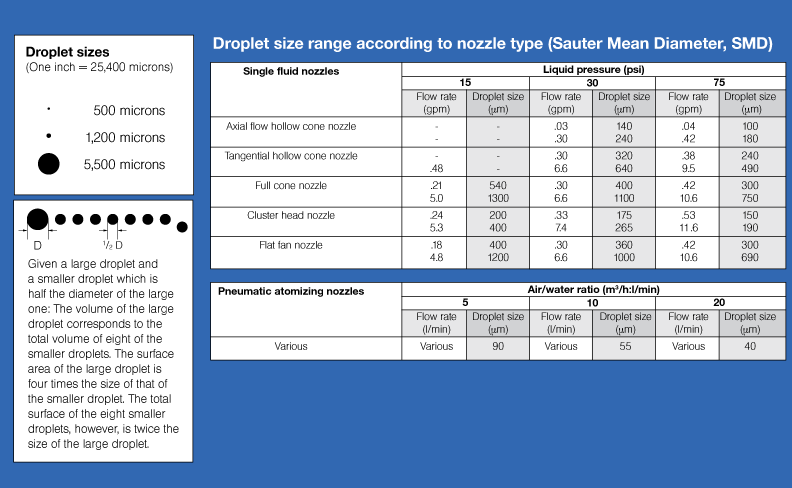Disinfection with Lechler nozzles: Safety for your Well Being
Disinfection is about neutralizing potentially harmful material harmless so that there is no longer any risk of infection from this material. Lechler nozzles make a decisive contribution here.

A summary of important facts:
Where is disinfection necessary?
Disinfection is necessary wherever germs, viruses or bacteria occur and can cause damage. This typically occurs in hospitals , but can also be found in food production or textile care and cleaning. Disinfectants are also important in normal household use.
How is disinfection done?
During disinfection, the bacterial count is brought to an critical level by a suitable disinfectant. In addition to the choice of the right disinfectant, attention must also be paid to the correct performance and the exposure time of the disinfectant.
What must be observed?
Common disinfectants are for example peracetic acid, hydrogen peroxide, aldehydes, alcohols and - as known from indoor and outdoor swimming pools - chlorine. All these are dangerous products, which is why careful and well-dosed use is strongly recommended. For the correct dosage it helps to atomize the media with nozzles.
Why atomization?
Disinfectants should be atomized as finely as possible, since fine drops increase the reactive surface significantly.

Overview drop sizes and drop volumes
A large reactive surface is important to ensure that disinfectant is applied to each area and that the agent can act in a targeted manner. In addition, a large reactive surface helps to save medium, which reduces costs and is good for the environment.
Use of disinfection – Application examples
Disinfection and hygiene applications
- Hand disinfection
- Work equipment disinfection
- Sole and boot cleaning
- Room disinfection
- Disinfection of work sluices
Which nozzles can be used for disinfection?
Single-fluid nozzles for disinfection
To generate the necessary fine droplets for a large surface, hollow cone nozzles are generally used. Depending on the required volume flow and the surface to be disinfected, different capacity sizes can be used.
The Lechler series 220 and 214/216 made of high-quality stainless steel 1.4404 are particularly suitable for the atomization of disinfectants.
Fine atomization of smallest quantities
Series 220
Extremely fine, fog-like hollow cone spray.
- Spray angle: 60°, 80°
- V [gal/min] (at p = 72 psi): 0.003 – 0.10
- Connection: 1/4" NPT
Fine atomization with a uniform spray
Series 214/216
Fine, uniform hollow cone spray.
- Spray angle: 60°, 80° (214); 60°, 90° (216)
- V [gal/min] (at p = 30 psi): 0.021 – 0.08 (214); 0.11 – 2.25 (216)
- Connection: 1/8 NPT (214); 3/8 NPT (216)
Disinfection with impact – Nozzles to disinfect work equipment
Series 664/665
Automatic jet alignment due to dove-tail guide. Stable spray angle. Uniform, parabolic distribution of liquid. Spray pipes with these nozzles show an extremely uniform total liquid distribution.
- Spray angle: 20°, 30°, 45°, 60°, 75°, 90°,120°
- V [gal/min] (at p = 30 psi): 1.67 – 16.64
- Connection: Assembly with 3/4 lock nut and dove-tail guide
Twin-fluid nozzles for disinfection
If the drops need to be minimal, the use of a two-substance nozzles is recommended. By using compressed air as the atomizing medium, the liquid pressure can be kept low resulting in very fine drops which produce a large reactive surface. In addition to surface disinfection, these nozzles can also be used for entire rooms.
For this purpose the Lechler series 136, 176 and the Lechler two-component atomizing lances are recommended.
Disinfection with flexibility
Series 136.4
Particularly fine flat fan atomization with air or gas.
- Spray angle: 45°, 60°, 80°
- V [gal/min] (at p = 30 psi): 0.026 – 20.10
- Mixing of fluids: inside
- Mode of liquid supply: Pressure principle
Disinfection with flexibility
Series 136.5
Particularly fine flat fan atomization with air or gas.
- Spray angle: 60°
- V [gal/min] (at p = 30 psi): 0.21 – .85
- Mixing of fluids: inside
- Mode of liquid supply: Siphon or gravity principle
Disinfection with flexibility
Series 176 ViscoMist™
Possibility of independent regulation of both atomizing air and fan air, which provides the user with infinite control over the viscous fluid’s spray pattern and droplet size.
- Spray angle: variable
- V Water [l/h]: 7.80 – 307.00
- Mixing of fluids: outside
- Mode of liquid supply: Pressure principle
Disinfection with flexibility
Lechler twin-fluid atomizing lances
Finest atomization, maximum reactive surface.







